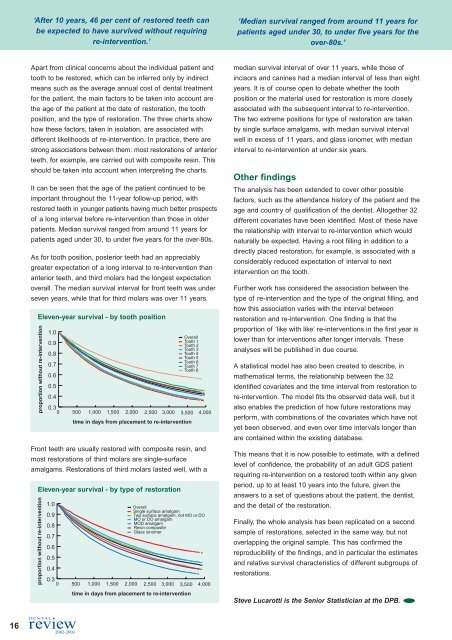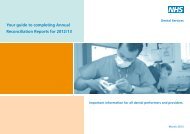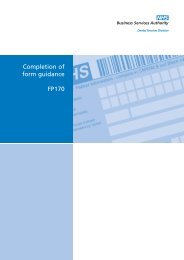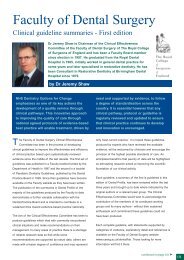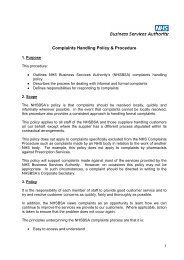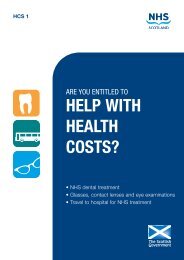DENTAL - NHS Business Services Authority
DENTAL - NHS Business Services Authority
DENTAL - NHS Business Services Authority
- No tags were found...
You also want an ePaper? Increase the reach of your titles
YUMPU automatically turns print PDFs into web optimized ePapers that Google loves.
‘After 10 years, 46 per cent of restored teeth canbe expected to have survived without requiringre-intervention.’‘Median survival ranged from around 11 years forpatients aged under 30, to under five years for theover-80s.’Apart from clinical concerns about the individual patient andtooth to be restored, which can be inferred only by indirectmeans such as the average annual cost of dental treatmentfor the patient, the main factors to be taken into account arethe age of the patient at the date of restoration, the toothposition, and the type of restoration. The three charts showhow these factors, taken in isolation, are associated withdifferent likelihoods of re-intervention. In practice, there arestrong associations between them: most restorations of anteriorteeth, for example, are carried out with composite resin. Thisshould be taken into account when interpreting the charts.It can be seen that the age of the patient continued to beimportant throughout the 11-year follow-up period, withrestored teeth in younger patients having much better prospectsof a long interval before re-intervention than those in olderpatients. Median survival ranged from around 11 years forpatients aged under 30, to under five years for the over-80s.As for tooth position, posterior teeth had an appreciablygreater expectation of a long interval to re-intervention thananterior teeth, and third molars had the longest expectationoverall. The median survival interval for front teeth was underseven years, while that for third molars was over 11 years.Eleven-year survival - by tooth positionproportion without re-interventionFront teeth are usually restored with composite resin, andmost restorations of third molars are single-surfaceamalgams. Restorations of third molars lasted well, with aproportion without re-intervention1.00.90.80.70.60.50.40.30 500 1,000 1,500 2,000 2,500 3,000 3,500 4,000Eleven-year survival - by type of restoration1.00.90.80.70.60.50.4time in days from placement to re-interventionOverallSingle surface amalgamTwo surface amalgam, not MO or DOMO or DO amalgamMOD amalgamResin compositeGlass ionomer0.30 500 1,000 1,500 2,000 2,500 3,000 3,500 4,000time in days from placement to re-interventionOverallTooth 1Tooth 2Tooth 3Tooth 4Tooth 5Tooth 6Tooth 7Tooth 8median survival interval of over 11 years, while those ofincisors and canines had a median interval of less than eightyears. It is of course open to debate whether the toothposition or the material used for restoration is more closelyassociated with the subsequent interval to re-intervention.The two extreme positions for type of restoration are takenby single surface amalgams, with median survival intervalwell in excess of 11 years, and glass ionomer, with medianinterval to re-intervention at under six years.Other findingsThe analysis has been extended to cover other possiblefactors, such as the attendance history of the patient and theage and country of qualification of the dentist. Altogether 32different covariates have been identified. Most of these havethe relationship with interval to re-intervention which wouldnaturally be expected. Having a root filling in addition to adirectly placed restoration, for example, is associated with aconsiderably reduced expectation of interval to nextintervention on the tooth.Further work has considered the association between thetype of re-intervention and the type of the original filling, andhow this association varies with the interval betweenrestoration and re-intervention. One finding is that theproportion of ‘like with like’ re-interventions in the first year islower than for interventions after longer intervals. Theseanalyses will be published in due course.A statistical model has also been created to describe, inmathematical terms, the relationship between the 32identified covariates and the time interval from restoration tore-intervention. The model fits the observed data well, but italso enables the prediction of how future restorations mayperform, with combinations of the covariates which have notyet been observed, and even over time intervals longer thanare contained within the existing database.This means that it is now possible to estimate, with a definedlevel of confidence, the probability of an adult GDS patientrequiring re-intervention on a restored tooth within any givenperiod, up to at least 10 years into the future, given theanswers to a set of questions about the patient, the dentist,and the detail of the restoration.Finally, the whole analysis has been replicated on a secondsample of restorations, selected in the same way, but notoverlapping the original sample. This has confirmed thereproducibility of the findings, and in particular the estimatesand relative survival characteristics of different subgroups ofrestorations.Steve Lucarotti is the Senior Statistician at the DPB.<strong>DENTAL</strong>16 review2002-2003


